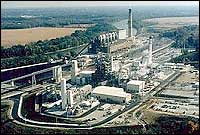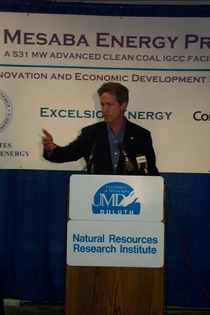Ray Cox thinks coal gasification is proven — HA!!!!!!
October 30th, 2005
It’s so goofy when people pontificate about something they know nothing about.

Coal gasification, the technology of the Mesaba DEMONSTRATION project, is anything but proven. Even the DOE knows this, and states “DEMONSTRATION” in all their materials – -check the DOE’s NOI, which acknowledges the risk of this project and discusses the serious technological problems. Where does Ray get these crazy ideas? It’s like the guy at the Taconite meeting who was trying to say that it wasn’t a wetland — if he won’t believe his eyes, I wish he’d read the Notice of proposed Floodplain and Wetlands Involvement! Humans have such aversion to reality!
The most recent attempt at coal gasification was the Wabash River plant, where they repowered an old coal plant with a 262MW coal gasification DEMONSTRATION project.

Imagine this nestled in the woods and bogs of the Range!
Mesaba and Wabash are DEMONSTRATION projects, deemed by the DOE as too risky for private development and which must be supported by grants and federally guaranteed loans.
Here’s the Wabash River Coal Gasification Repowering Project – Final Technical Report which will tell you all about the problem experienced.
Construction costs were twice what they expected
Wastewater was “routinely” in violation of the permit due to high levels of selenium, cyanide and arsenic, and the problem had not been corrected by the time of this report.
Plant had 36-38% efficiency factor – that’s regarded as GOOD!
Plant was out of service much of the demonstration time, towards end had 60% capacity factor. That’s 19% better than an NEG Micon wind turbine!
They often say that the plant was “unavailable” and it would be a tad bit more honest if they’d say that the plant was shut down because they couldn’t or didn’t pay their gas bill!
Here’s a couple more blurbs on Wabash:
Wabash River Coal Gasification Project: A DOE Assessment This report is from January 2002, after the “final” report.
Wabash River Coal Gasification Project: An Update This report is from September 2000, just after the “final” report.
Here’s the CCPI Public Abstract for Mesaba.
Here’s a handout from the meeting, Project Facts, Mesaba Energy Project.
Here’s a Power Point from October 2005! Excelsior Energy, Inc.: A CCPI Round 2 Project.
Coal gasification goes back a bit further, but not much in the way of projects. There have been very few over the last 30 years. In the 70’s, there were two STEAG plants in Europe, and following that, air blown and oxygen blown were compared with the STEAG plants, with the US plants winning out. The EPRI report on this was prepared by FLOUR, the Mesaba engineers on the project (see Economic Evaluation of GCC Power Plants based on the STEAG Combined-Cycle Design and Comparison With a U.S. Combined-Cycle-Based System, EPRI AF-1288; see also Economic Studies of Coal Gasification Combined Cycle Systems for Electric Power Generation, EPRI AF-642, Flour; An Economic Evaluation of MHD-Steam Powerplants Employing Coal Gasification, RI 7796, Bergman, Plants, Demeter & Bienstock).
Yup, Ray’s not the only one who hasn’t a clue, but that’s what happens when you don’t do your homework and rely on lobbyists — for this “Two Lobbyists and a Wife” project, that’s an obviously flawed approach!

I feel another “Generation for Volt Dolts” coming on…
October 30th, 2005 at 9:32 am
Good lord, Carol, relax! The technology does in fact turn coal into synthetic gas, which can be used to generate electricity — so its proven in that sense. Reliability of the gasifiers is an issue that will be very important going forward, so we don’t have the same level of comfort with this technology as we have with, say, coal combustion, so there is a good deal more uncertainty involved relative to conventional technologies. But, ultimately, if we’re going to continue to use coal as a fuel (and I think we are), conventional technologies are going to have to give way to coal gasification technologies.